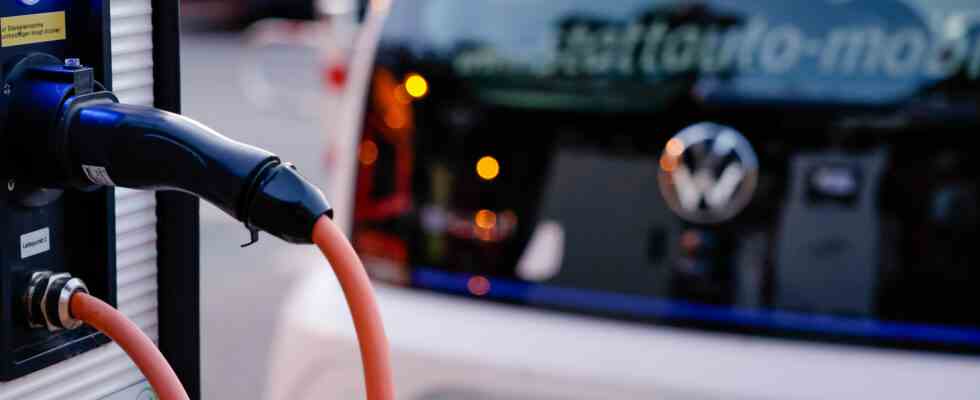Status: 06.01.2023 09:17
The car manufacturer Mercedes-Benz wants to set up its own charging network for electric cars. Other car companies are also working on the charging infrastructure because they don’t want to rely on politicians for help.
So far, the lack of charging options and the worry of being stranded with an empty battery has deterred many people from switching to electric cars. And the expansion of the e-charging network is still lagging behind the growing number of electric cars. At the beginning of 2021, 14 e-cars came to a charging point, according to figures from the German Association of the Automotive Industry (VDA), it was 23 most recently.
Mercedes wants to attract customers
Although the federal government wants to take countermeasures, a number of car manufacturers do not want to rely solely on politicians and are pushing ahead with the development of the charging infrastructure themselves. Yesterday, Mercedes-Benz also announced its own network with 10,000 charging points worldwide by the end of the decade. The group wants to invest a single-digit billion amount for this.
“We don’t want to watch and wait until it’s built, so we’re building a global fast charging network ourselves,” said Mercedes boss Ola Källenius. At first it was thought that other players such as energy companies would meet the demand, said Head of Technology Markus Schäfer. “But that didn’t happen.”
Mercedes did not say how many charging points will be created in Germany. But for the global expansion goals – the federal government alone wants one million publicly accessible plugs by 2030 – the plans of the Stuttgart-based company are a drop in the bucket. Källenius made no secret of this in conversation with journalists. Rather, it is about attracting more Mercedes customers. They should benefit, for example, from preferred use by means of a reservation.
Charging networks through cooperation
Because the charging networks that the car companies have secured through cooperation are much larger. Around one million charging points are available worldwide for Mercedes drivers, said Källenius. The Digital Charging Solutions network (DCS), which goes back to a BMW initiative and in which Mercedes and the oil company BP are also involved, claims to have more than 400,000 charging points in Europe in Japan.
Together with BMW, VW, Ford and Hyundai, Mercedes operates the Ionity consortium, which has so far set up 480 fast charging stations in Germany with a charging capacity of up to 350 kilowatts.
The car manufacturer Stellantis also started to set up its fast charging network in Italy in 2021. In addition to the Atlante project, which is limited to southern Europe, there is a cooperation with the provider TheF Charging to set up a network with more than 15,000 locations and two million parking spaces by 2025.
Are politicians doing enough?
So has politics overslept the expansion of the charging infrastructure so much in recent years that the auto industry sees the only way out in its own initiative? VDA President Hildegard Müller puts it this way: “The expansion of the charging infrastructure is a joint task that can only succeed if everyone involved supports it and takes responsibility.” Everyone has to make their contribution, and of course the automotive industry is also involved.
A look at the figures shows that the government’s goals are still a long way off. According to data from the Federal Network Agency from the beginning of November 2022, the number of charging points grew by around 17,000 to a total of 72,000 within a year. If things continued at this rate, the target of one million charging points would not be reached until 2077, in purely mathematical terms. In order to become faster, the cabinet decided in October on a “master plan for charging infrastructure” and wants to spend 6.3 billion euros on it.
Above all, fast charging points are missing
That at least shows that the federal government is aware of the Herculean task, according to the ADAC. The automobile club assessed the pace of expansion in 2022 as comparatively positive. After all, the number of charging points in the past year has kept pace with the number of newly registered e-cars, praised VDA boss Müller. But: “Supply would have to outpace demand so that people’s trust in e-mobility can continue to grow.” Germany is still a long way from that. The fast chargers in particular must therefore continue to move forward at high speed.
For Germany, the Federal Network Agency has so far counted around 12,000 such plugs, which are defined as fast charging points with a charging capacity of more than 22 kilowatts. Around a quarter of them achieve the highest performance class of over 300 kilowatts. Mercedes also wants to advance into these areas with its new infrastructure. A battery can be charged from 10 to 80 percent in around half an hour. “We will shorten it significantly,” announced technical director Schäfer at the CES technology fair in Las Vegas. With a better charging infrastructure, the acceptance of electric cars will increase.
There is a lack of customer friendliness
The energy company EnBW estimates that by 2030 around 130,000 to 150,000 fast charging points will be needed nationwide and not a million mostly slower normal charging points to supply the 15 million electric cars targeted by the federal government. EnBW intends to build around 30,000 of these itself. With 2,800 charging points, the group already operates what it claims to be the largest fast charging network in Germany.
What about the user-friendliness in view of the umpteen providers? The ADAC complained that an electric car driver can quickly lose track. Sometimes he needs a charging card, sometimes an app. At this pillar he pays by smartphone, at the other by bill at the end of the month. Some providers charge a basic fee, some a surcharge per minute after a certain time at the charging station. So there is still a lot to do on the way to fully electric mobility.

